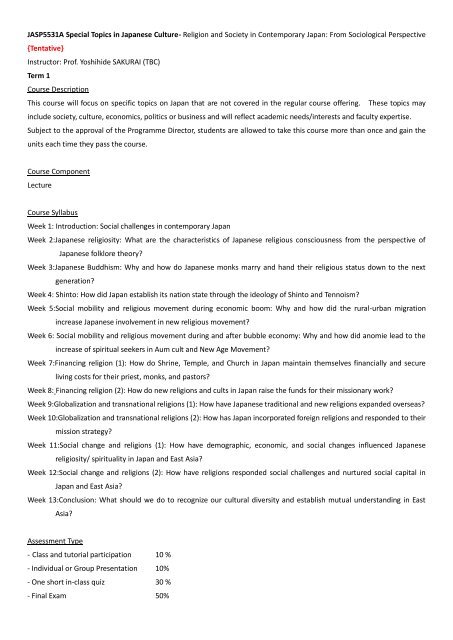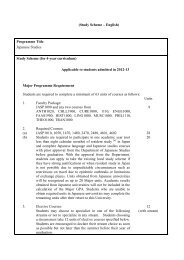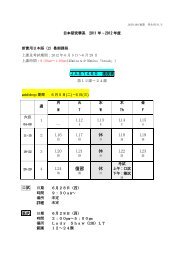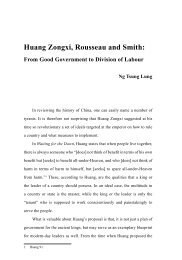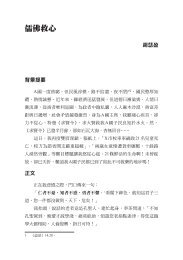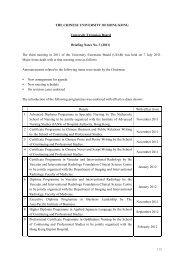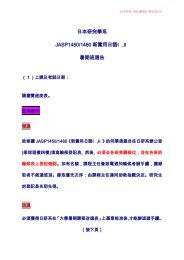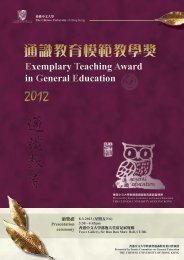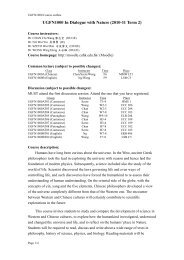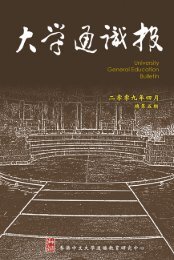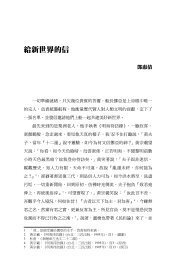JASP5531A Special Topics in Japanese Culture- Religion and ...
JASP5531A Special Topics in Japanese Culture- Religion and ...
JASP5531A Special Topics in Japanese Culture- Religion and ...
You also want an ePaper? Increase the reach of your titles
YUMPU automatically turns print PDFs into web optimized ePapers that Google loves.
<strong>JASP5531A</strong> <strong>Special</strong> <strong>Topics</strong> <strong>in</strong> <strong>Japanese</strong> <strong>Culture</strong>- <strong>Religion</strong> <strong>and</strong> Society <strong>in</strong> Contemporary Japan: From Sociological Perspective{Tentative}Instructor: Prof. Yoshihide SAKURAI (TBC)Term 1Course DescriptionThis course will focus on specific topics on Japan that are not covered <strong>in</strong> the regular course offer<strong>in</strong>g. These topics may<strong>in</strong>clude society, culture, economics, politics or bus<strong>in</strong>ess <strong>and</strong> will reflect academic needs/<strong>in</strong>terests <strong>and</strong> faculty expertise.Subject to the approval of the Programme Director, students are allowed to take this course more than once <strong>and</strong> ga<strong>in</strong> theunits each time they pass the course.Course ComponentLectureCourse SyllabusWeek 1: Introduction: Social challenges <strong>in</strong> contemporary JapanWeek 2:<strong>Japanese</strong> religiosity: What are the characteristics of <strong>Japanese</strong> religious consciousness from the perspective of<strong>Japanese</strong> folklore theory?Week 3:<strong>Japanese</strong> Buddhism: Why <strong>and</strong> how do <strong>Japanese</strong> monks marry <strong>and</strong> h<strong>and</strong> their religious status down to the nextgeneration?Week 4: Sh<strong>in</strong>to: How did Japan establish its nation state through the ideology of Sh<strong>in</strong>to <strong>and</strong> Tennoism?Week 5:Social mobility <strong>and</strong> religious movement dur<strong>in</strong>g economic boom: Why <strong>and</strong> how did the rural-urban migration<strong>in</strong>crease <strong>Japanese</strong> <strong>in</strong>volvement <strong>in</strong> new religious movement?Week 6: Social mobility <strong>and</strong> religious movement dur<strong>in</strong>g <strong>and</strong> after bubble economy: Why <strong>and</strong> how did anomie lead to the<strong>in</strong>crease of spiritual seekers <strong>in</strong> Aum cult <strong>and</strong> New Age Movement?Week 7:F<strong>in</strong>anc<strong>in</strong>g religion (1): How do Shr<strong>in</strong>e, Temple, <strong>and</strong> Church <strong>in</strong> Japan ma<strong>in</strong>ta<strong>in</strong> themselves f<strong>in</strong>ancially <strong>and</strong> secureliv<strong>in</strong>g costs for their priest, monks, <strong>and</strong> pastors?Week 8: F<strong>in</strong>anc<strong>in</strong>g religion (2): How do new religions <strong>and</strong> cults <strong>in</strong> Japan raise the funds for their missionary work?Week 9:Globalization <strong>and</strong> transnational religions (1): How have <strong>Japanese</strong> traditional <strong>and</strong> new religions exp<strong>and</strong>ed overseas?Week 10:Globalization <strong>and</strong> transnational religions (2): How has Japan <strong>in</strong>corporated foreign religions <strong>and</strong> responded to theirmission strategy?Week 11:Social change <strong>and</strong> religions (1): How have demographic, economic, <strong>and</strong> social changes <strong>in</strong>fluenced <strong>Japanese</strong>religiosity/ spirituality <strong>in</strong> Japan <strong>and</strong> East Asia?Week 12:Social change <strong>and</strong> religions (2): How have religions responded social challenges <strong>and</strong> nurtured social capital <strong>in</strong>Japan <strong>and</strong> East Asia?Week 13:Conclusion: What should we do to recognize our cultural diversity <strong>and</strong> establish mutual underst<strong>and</strong><strong>in</strong>g <strong>in</strong> EastAsia?Assessment Type- Class <strong>and</strong> tutorial participation 10 %- Individual or Group Presentation 10%- One short <strong>in</strong>-class quiz 30 %- F<strong>in</strong>al Exam 50%
JASP5531B <strong>Special</strong> <strong>Topics</strong> <strong>in</strong> <strong>Japanese</strong> <strong>Culture</strong>- <strong>Special</strong> <strong>Topics</strong> <strong>in</strong> <strong>Japanese</strong> <strong>Culture</strong> {Tentative}Instructor: Prof. Tai Wei LIMTerm 1Course DescriptionThis course enables students to develop a solid underst<strong>and</strong><strong>in</strong>g of <strong>Japanese</strong> management systems <strong>and</strong> practices. The topicscovered <strong>in</strong>clude cultural issues <strong>in</strong> bus<strong>in</strong>ess, keiretsu systems, human resource management practice, <strong>and</strong> corporategovernance, <strong>and</strong> strategies <strong>in</strong> relation to global trends. Class meet<strong>in</strong>gs will consist of a mix of lecture <strong>and</strong> class discussion<strong>and</strong> presentations on the selected topics.Course ComponentLectureCourse SyllabusWeek 1: Inside the <strong>Japanese</strong> Bus<strong>in</strong>ess Organizations: Zaibatsu, Keiretsu, Sogo ShoshaWeek 2: <strong>Japanese</strong> Management Philosophy <strong>and</strong> Techniques: LTE, Job Rotation, Seniority-Based Promotion, R<strong>in</strong>gi SystemsWeek 3:<strong>Japanese</strong> Management Philosophy <strong>and</strong> Techniques: JIT, TQC, QC, Kaizen, Suggestion system, Toyota productionsystemWeek 4: Market<strong>in</strong>g: The <strong>Japanese</strong> Way - Sell<strong>in</strong>g Products <strong>and</strong> NegotiationsWeek 5: Case Study 1: Design <strong>and</strong> market<strong>in</strong>gWeek 6: Case Study 2: Technology use <strong>and</strong> salesWeek 7:Case Study 3: Energy <strong>and</strong> Environment: Case studies of energy use <strong>in</strong> the Arita Ceramics Industry <strong>and</strong>Environmentally-friendly Tourism.Week 8: Case Study 4: Comparative perspectives: <strong>Japanese</strong> bus<strong>in</strong>esses <strong>in</strong> the HK <strong>and</strong> Ch<strong>in</strong>a marketsWeek 9: <strong>Japanese</strong> Management: Project work presentationWeek 10: <strong>Japanese</strong> Management: Project work presentationWeek 11: <strong>Japanese</strong> Management: Project work presentationWeek 12: <strong>Japanese</strong> Management: ConclusionAssessment Type- Participation 15 %- Attendance 10%- Group Presentation 50%- Group written report 25 %
JASP5615 Anthropology of Japan {Tentative}Instructor: Prof .Lynne NAKANOTerm 1Course DescriptionThis course exam<strong>in</strong>es major anthropological approaches to <strong>Japanese</strong> society <strong>and</strong> culture. These approaches <strong>in</strong>clude thosethat view Japan as a cultural whole such as the cultural <strong>and</strong> personality paradigm, ethnographic approaches,modernization <strong>and</strong> development theories, globalization theories, structural approaches, neoMarxism, fem<strong>in</strong>ism,postmodernism, <strong>and</strong> cultural studies approaches. Each week, lectures will <strong>in</strong>troduce a particular approach to Japan, <strong>and</strong>the assigned read<strong>in</strong>gs will provide examples of that approach. Students will be asked to discuss the read<strong>in</strong>gs <strong>and</strong> thedifferent approaches <strong>in</strong>troduced <strong>in</strong> the lectures.Course ComponentLectureCourse SyllabusWeek 1: Introduction to Anthropology <strong>and</strong> <strong>Culture</strong>Week 2: Problematiz<strong>in</strong>g JapansWeek 3: EthnographyWeek 4: <strong>Culture</strong> <strong>and</strong> Personality ParadigmsWeek 5: Modernity <strong>and</strong> DevelopmentWeek 6: Structures, Ideas <strong>and</strong> Mean<strong>in</strong>gWeek 7: The State, NeoMarxism <strong>and</strong> Political EconomyWeek 8: Power <strong>and</strong> ResistanceWeek 9: Gender, Fem<strong>in</strong>ism <strong>and</strong> Women’s StudiesWeek 10: Japan <strong>and</strong> GlobalizationWeek 11: Japan <strong>in</strong> the WorldWeek 12: Postmodernism <strong>and</strong> JapanAssessment Type- Book review 20 %- Class participation 20%- Mid-term Essay 30%- F<strong>in</strong>al Essay 30%


